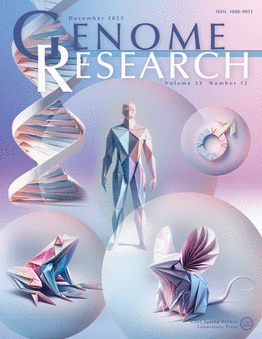对CLL和MDS患者进行长线程转录组测序,揭示SF3B1突变的分子效应
IF 6.2
2区 生物学
Q1 BIOCHEMISTRY & MOLECULAR BIOLOGY
引用次数: 0
摘要
剪接因子 3B 亚基 1(SF3B1)的突变经常发生在慢性淋巴细胞白血病(CLL)和骨髓增生异常综合征(MDS)患者中。这些突变对疾病的预后有不同的影响,MDS 患者的预后较好,而 CLL 患者的预后较差。全长转录组方法可以扩展我们对SF3B1突变对RNA剪接的影响及其对患者生存和治疗选择的贡献的认识。我们对44例MDS和CLL患者以及两对有SF3B1突变和无SF3B1突变的同源细胞系进行了长片段转录组测序(LRTS),发现了60%的新型同工酶。剪接改变在很大程度上是不同癌症类型共有的,并特别影响到内含子和3'剪接位点的使用。我们的数据强调了在SF3B1突变患者中发生动态剪接位点切换的规范3'剪接位点的受限窗口。利用转录组范围的 RNA 结合图和分子动力学模拟,我们显示了 SF3B1 在 3' 剪接位点的多模式结合,并预测 SF3B1K700E 的第二个结合口袋的 RNA 结合减少。我们的研究是迄今为止对 CLL 和 MDS 中 SF3B1 突变进行的最完整的 LRTS 研究,为研究癌症中的剪接异常提供了资源。这些结果对于理解 SF3B1 突变在血液恶性肿瘤及其他相关疾病中的作用具有重要意义。本文章由计算机程序翻译,如有差异,请以英文原文为准。
Long-read transcriptome sequencing of CLL and MDS patients uncovers molecular effects of SF3B1 mutations
Mutations in splicing factor 3B subunit 1 (SF3B1) frequently occur in patients with chronic lymphocytic leukemia (CLL) and myelodysplastic syndromes (MDS). These mutations have different effects on the disease prognosis with beneficial effect in MDS and worse prognosis in CLL patients. A full-length transcriptome approach can expand our knowledge on SF3B1 mutation effects on RNA splicing and its contribution to patient survival and treatment options. We applied long-read transcriptome sequencing (LRTS) to 44 MDS and CLL patients, as well as two pairs of isogenic cell lines with and without SF3B1 mutations, and found >60% of novel isoforms. Splicing alterations were largely shared between cancer types and specifically affected the usage of introns and 3’ splice sites. Our data highlighted a constrained window at canonical 3’ splice sites in which dynamic splice site switches occurred in SF3B1-mutated patients. Using transcriptome-wide RNA binding maps and molecular dynamics simulations, we showed multimodal SF3B1 binding at 3’ splice sites and predicted reduced RNA binding at the second binding pocket of SF3B1K700E. Our work presents the hitherto most complete LRTS study of the SF3B1 mutation in CLL and MDS and provides a resource to study aberrant splicing in cancer. Moreover, we showed that different disease prognosis most likely results from the different cell types expanded during carcinogenesis rather than different mechanisms of action of the mutated SF3B1. These results have important implications for understanding the role of SF3B1 mutations in hematological malignancies and other related diseases.
求助全文
通过发布文献求助,成功后即可免费获取论文全文。
去求助
来源期刊

Genome research
生物-生化与分子生物学
CiteScore
12.40
自引率
1.40%
发文量
140
审稿时长
6 months
期刊介绍:
Launched in 1995, Genome Research is an international, continuously published, peer-reviewed journal that focuses on research that provides novel insights into the genome biology of all organisms, including advances in genomic medicine.
Among the topics considered by the journal are genome structure and function, comparative genomics, molecular evolution, genome-scale quantitative and population genetics, proteomics, epigenomics, and systems biology. The journal also features exciting gene discoveries and reports of cutting-edge computational biology and high-throughput methodologies.
New data in these areas are published as research papers, or methods and resource reports that provide novel information on technologies or tools that will be of interest to a broad readership. Complete data sets are presented electronically on the journal''s web site where appropriate. The journal also provides Reviews, Perspectives, and Insight/Outlook articles, which present commentary on the latest advances published both here and elsewhere, placing such progress in its broader biological context.
 求助内容:
求助内容: 应助结果提醒方式:
应助结果提醒方式:


